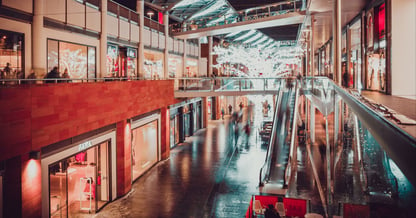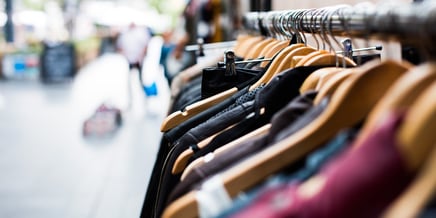
Improving In-Store Shopping Experience for Gen-Z Shoppers
The next wave of consumers, Generation Z, have come of age and primed for the digital era. These savvy shoppers prioritise experiences over products—even with...
Read more
4 minute read | 24/10/2019

Think of augmented reality (AR) as the technological cousin of the revolutionary virtual reality (VR). Using a smartphone camera, it blends what you see in front of you with added information or content on your screen. It’s an engaging interactive experience of a real-life scenario that envisages the product shoppers might buy.
Whether it’s a pair of trainers or a car, AR can help nudge shoppers into buying something. For example, Converse introduced The Shoe Sampler which allowed shoppers to see what the shoes would look like on their feet - without actually buying them. Then there’s Audi’s use of VR which allowed them to launch a customised customer experience.
Virtual showrooms are more dynamic and interactive. Immersing customers in this way can drive them to make a purchase. Implementing this in a store can be compelling and interesting for the customer, yet add real, tangible benefits for retailers.
It can drive footfall by creating a buzz around a particular area of the store and lead to increased dwell times.
Interactive retail displays create immersive experiences that stay with customers after they’ve left your store. They can be for an inventory display, digital storytelling or anything that captures attention from passers by.
Tiffany & Co is a good example of this, adding a vending machine stocked with products that offers shoppers a more unique experience, rather than just taking products off a shelf. Meanwhile, UGG footwear has utilised interactive signage systems which allow in-store customisation using RFID technology.
Interactive in-store innovations enable continuous operations as they can inform, serve and keep customers engaged.
Self-checkouts might have been revolutionary some years ago, but times have evolved and retailers are already pushing the boundaries on what can be achieved. The novelty of self check outs have worn off as they were first introduced in 1986. The act of physically scanning every item is tedious and hunting for a tag on an item can be frustrating. Now, retails are moving over to radio frequency identification chips (RFID).
Uniqlo was the first brand to enable these RFID check outs where customers effortlessly put all items into a box next to the self-checkout till, and it intuitively identifies the contents within. The items come up on the screen to confirm, then they can pay through contactless. This simple but smart technology has transformed the shopping experience because it's something new and relatively novel. It almost makes check out a fun little game and best of all, customers don't have to make small talk to staff registers and the shop doesn't have to employ more people.
Some companies have taken it a step further and removed checkouts altogether. This is where the customers simply pick up the products they want, leave and then an app automatically charges their bank accounts. Amazon introduced Amazon Go stores that uses computer vision, deep learning and sensor fusion technology to automate the payment and checkout process. This technology is known as Just Walk Out. Customers love the convenience and speed of being able to pick up a few items and leave without waiting in long ques.
Nike has followed suit with the Speed Shop. This allows customers to reserve shoes online to try on in-store. Customers can also arrive in the store (through a dedicated entrance), find a locker with their name on and unlock it with their smartphone. They can then use mobile checkout and quickly leave. This makes the shopping experience even more convenient.
Not every shopper has the time or the patience to queue up and wait for the fitting rooms to be available. One innovative way retailers can combat this issue is by introducing virtual reality fitting rooms where shoppers can envisage the items they want to buy.
This technology allows people to get an instant, accurate representation of what products will look like and how they’ll fit. This also makes the fitting room system more efficient. Adidas was previously in the process of creating VR changing rooms in the form of a body scanner, allowing shoppers to make risk-free purchases without returning items.
Since then, Amazon has announced plans for VR dressing rooms using a mix of displays, cameras and projectors. Gap has also teamed up with Google in a similar initiative to make fitting rooms a thing of the past in the hope that it can take over retail stores in the near future.
Combining online and offline channels can improve the retail industry. For example, retailers can implement terminals in-store where customers can search online to see if products are in stock and where they’re located. This is helpful as a lot of shoppers tend to check out online stores to see if something is in stock.
So, imagine if stores introduced a way for people to enter a store, approach an item they previously looked at and then receive a push notification through an app or email to their inbox. This can help drive further sales as it reduces the chances of customers forgetting items or persuades them into making an impulsive, last-second purchase.
Providing this information can also have an impact on dwell time, share targeted offers and incentives as well as encourage returning visitors.
By understanding customer behaviour, you can connect with them on different levels. By connecting both your online and offline experiences, you’re bound to end up with happier customers and hopefully maximise profits.
See how this has been achieved previously in the case study below.
Rebecca is the Marketing Director. She's worked for SPARK TSL since 2012. She is responsible for high level marketing strategy focusing on lead generation and aiding the vision of the business; to ensure that no patient has to pay for entertainment.
More articles by the author

The next wave of consumers, Generation Z, have come of age and primed for the digital era. These savvy shoppers prioritise experiences over products—even with...
Read more

Read more

Whatever you’re selling, you need to do everything you can to attract customers through your doors and keep them coming back after the sale. Smartphones and...
Read more